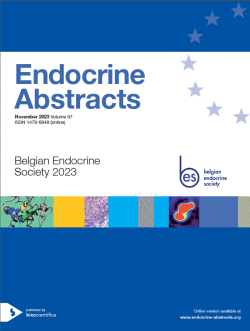BES 2023
Section
Hydrocortisone treatment increases cholesterol availability in prolonged septic mice: effect on adrenal and muscle functioning
Bruyn Lauren De , Arno Teblick , Oudenhove Tim Van , Perre Sarah Vander , Inge Derese , Lies Pauwels , Sarah Derde , Berghe Greet Van den , Lies Langouche
Protein tyrosine phosphatase receptor kappa regulates glycolysis, lipid metabolism and promotes hepatocyte reprogramming in obesity
Eduardo H Gilglioni , Li Ao , Wadsen St-Pierre-Wijckmans , Tzu-Keng Shen , Israel Perez-Chavez , Garnik Hovhannisyan , Daria Ezerina , Michela Lisjak , Andre Dias , Javier Negueruela , Mamnez Julia Bauza- , Jose Maria Herranz , Stephane Demine , Zheng Feng , Thibaut Vignane , Lukas Otero , Flavia Lambertucci , Alena Prasnicka , Jacques Deviere , Jose Antonio Encinas , Sumeet Pal Singh , Joris Messens , Milos Filipovic , Eric Trepo , Hayley Sharpe , Wei Wu , Esteban N Gurzov
Low-dose anti-thymocyte globulin in combination with verapamil reverses hyperglycaemia in newly diagnosed diabetic NOD mice
P. J. Martens , M. Viaene , D. Ellis , N. Geukens , C Mathieu , C. Gysemans
Androgen Deprivation Modulates the Adrenocortical Stress Response
V. Sommers , M. Gentenaar , E. Viho , C. Helsen , V. Dubois , J. Kroon , B. Decallonne , F. Claessens , O.C. Meijer
Insulin resistance is associated with worse CGM-derived parameters in people with type 1 diabetes
Isabel Clinck , Jonahtan Mertens , Kristien Wouters , Eveline Dirinck , Block Christophe De
Effects of Long-term Testosterone Treatment in Transgender People without Gender-Affirming Surgery: the ELANTES study
Karen Decaestecker , Jeroen Vervalcke , Visschere Pieter De , Steven Weyers , Guy T'Sjoen
Dose Reduction of Cyproterone Acetate in Trans Women and the Effect on Patient- reported Outcomes: Results from the ENIGI Study
Tim Flamant , Jeroen Vervalcke , Guy T'Sjoen
Post-Hypoglycemic Hyperglycemia Are Highly Relevant Markers For Stratification Of Glycemic Variability and Remission Status Of Pediatric Patients With New-Onset Type 1 Diabetes
Antoine A Harvengt , Olivier G Polle , Manon Martin , Aline van Maanen , Laurent Gatto , Philippe A Lysy
A retrospective study of people with familial hypercholesterolemia in a Belgian lipid clinic
V Ide , Cock D De , S Pazmino , R Vangoitsenhoven , Schueren B Van der , A Mertens
Cortical bone assessment and determinants in children and adolescents with Klinefelter syndrome
Maartje Hickmann , Elise Nauwynck , Caroline Ernst , Inneke Willekens , Jesse Vanbesien , Willem Staels , Schepper Jean De , Inge Gies
Development of the KASAI score as a predictive tool for the uni- or bilateral form of primary hyperaldosteronism
G Pierman , D Maiter , RM Furnica
Endocrine manifestations in 22q11.2 deletion syndrome: a retrospective single center cohort study
Eva Soubry , Karel David , Ann Swillen , Elfi Vergaelen , Op de Beeck Marie Docx , Margo Hulsmans , Sara Charleer , Brigitte Decallonne
Acquired idiopathic isolated adrenocorticotropic hormone deficiency: a descriptive systematic review of a heterogeneous and underreported disease
Mieghem E Van , Block C De , Herdt C De
In otherwise healthy young men, Trabecular Bone Score (TBS) is significantly lower in case of insulin resistance: an analysis of the SIBLOS study
Offel Steven Van , Charlotte Verroken , Stefan Goemaere , Bruno Lapauw
The thiazide challenge test differentiates primary hyperparathyroidism from secondary hyperparathyroidism due to idiopathic hypercalciuria
Ewout Verly , Charlotte Verroken , Bruno Lapauw
SHBG assay performance and the effect of SHBG assay choice on calculated free testosterone
Joeri Walravens , Tim Reyns , Eynde Tibbert Van Den , Joanne Adaway , Brian Keevil , Tom Fiers , Bruno Lapauw
Unilateral mydriasis as a first presentation of pituitary macroadenoma
Tim Ailliet , Axelle Cools , Haecke Helena Van , Nikolaas Vantomme , Sylvie Vandelanotte , Bruel Annick Van Den
Is this pancreatic NET responsible for an ectopic ACTH-dependent Cushing’s syndrome?
Johanna Angelini , Carole Bourmorck , Devuyst France , Driessens Natacha
In search of the source; a challenging diagnostic work-up of ACTH dependent Cyclic Cushing syndrome
Stephanie Buyse , Bruno Lapauw
Hypercalcemia during pregnancy, how to manage it, discussion of a case study
T Carton , N Bahar , B Corvilain
A non-controlled Cushing disease treated with osilodrostat: A case report
L Depoorter , Block C De , Herdt C De
Primary infertility: a rare presentation of adrenocortical carcinoma
S Desmedt , Vijver A Van De , E Van Caenegem , S Vandewalle
A unique cause of hypermetabolic adrenal incidentaloma
Xavier Gilis , Thomas Servais , Marie-Cecile Nollevaux , Etienne Delgrange
A case of calcitriol-mediated hypercalcemia in a patient with solid tumor
M. Lomre , N. Sirtaine , K. Van Den Eynde , P. Kleynen , C. Martinez-Mena , K.G. Poppe
An extremely rare cause of psychosis, hypokalemia, and metabolic alkalosis
N. Mutebi , Leu N. De , D. Unuane
Solving the puzzle of MEN2B syndrome in an adolescent girl
E Nauwynck , J Vanbesien , I Gies , C Ernst , S Raeymaeckers , G Verfaillie , W Waelput , F Vaeyens , J De Greve , J De Schepper , W Staels
Two family members with partial hypopituitarism and gingival fibromatosis caused by a missense mutation in KCNQ1
A Sabbe , Block C De , F Eyskens , Rademaecker M De , Herdt C De
A diagnostic conundrum in Bardet-Biedl syndrome: when genetics precede clinical diagnosis
Roy Nele Van , Sylvester Heerwegh , Dashty Husein , Joke Ruys , Peter Coremans
Challenges in Pregnancy Diagnosis: A Case Report of Persistently Elevated hCG Levels
L Wauthier , L Courcelles , D Gruson




